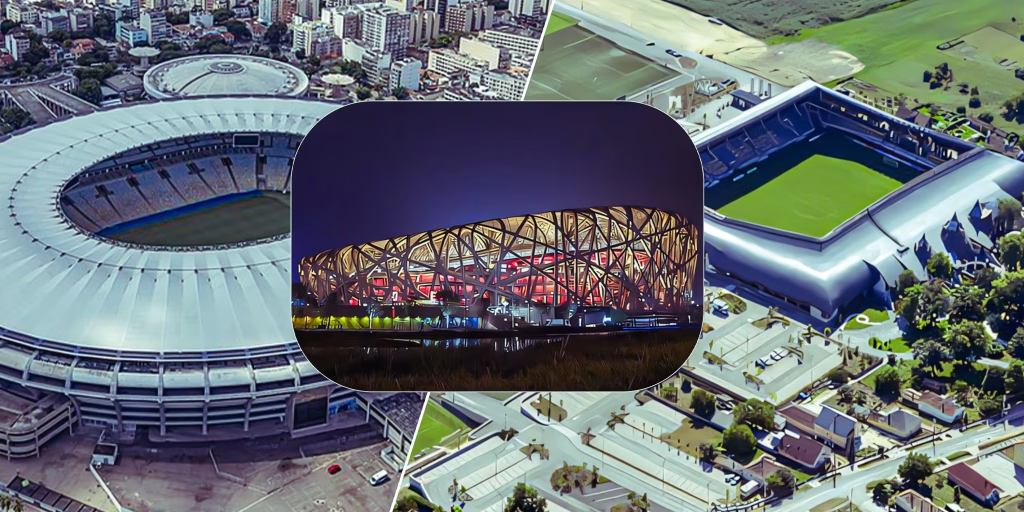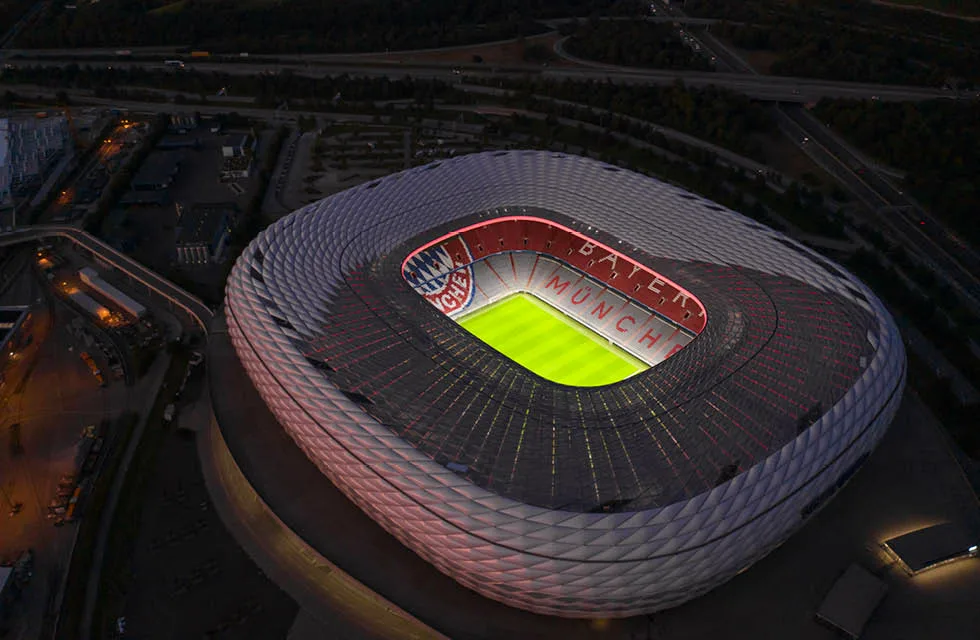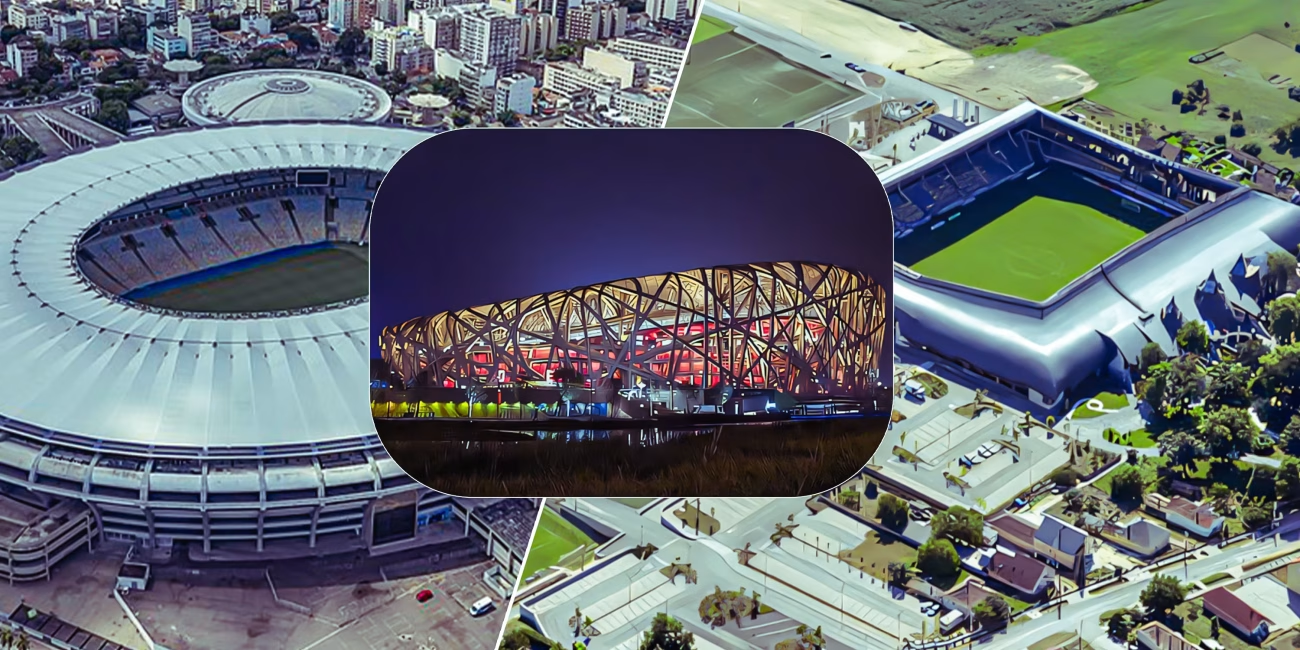Introduction: Why Stadiums Cost Billions
Every few years, we see a new sports stadium open or be planned, and people inevitably ask: How much did that cost? Stadiums are no longer just places where matches are played—they are modern marvels combining architecture, technology, fan experience, retail, and even real estate. In 2025, the price tags are astronomical.
With more than ten years covering sports infrastructure, stadium builds, and sports business, I’ve seen how costs escalate—from land and materials to design features. In this article, we’ll go through the top 10 most expensive sports stadiums in the world as of 2025. We’ll compare costs, features, locations, and what makes each stadium stand out (or over-budget). If you care about architecture, sports business, or just want to know which stadiums broke the bank, this list is for you.

What Determines a Stadium’s Cost?
Before listing the top 10, let’s pause and look at what pushes stadium costs into the billions:
- Design Complexity: Retractable roofs, large screens, high-tech lighting, retracting pitches, multi-use functions (concerts, sports, events).
- Capacity & Location: Urban land is expensive. Building in city centers often means higher land, infrastructure, transport costs.
- Materials & Construction Costs: Inflation, labor costs, steel, concrete, specialized materials.
- Amenities: VIP suites, luxury boxes, restaurants, commercial spaces, parking, fan interaction zones.
- Regulation & Infrastructure: Local building codes, environmental / sustainability features, transit access, community impact.
These factors mean a stadium that seems “just” for sports can cost like a mixed-use real estate project. Now, with that in mind, here are the top 10 most expensive sports stadiums in the world as of 2025.
Top 10 Most Expensive Sports Stadiums in the World 2025
Here are the stadiums with the highest construction or development costs, adjusted or reported, combining recent builds with ones still breaking records into 2025.
| Rank | Stadium | Location | Approximate Cost* | Notable Features |
|---|---|---|---|---|
| 1 | SoFi Stadium | Inglewood, California, USA | US$5.5 billion Wikipedia+3WorldAtlas+3Construction Disputes+3 | Home of LA Rams & Chargers; multi-venue complex, huge video boards, luxury amenities. |
| 2 | MetLife Stadium | East Rutherford, New Jersey, USA | ~US$2.03 billion WorldAtlas+2SportsRender+2 | Shared by two NFL teams; advanced facilities; major events hosted. |
| 3 | Allegiant Stadium | Paradise, Nevada, USA | ~US$1.9-2.3 billion SportsRender+2SportsRender+2 | Retractable field, climate control, Las Vegas location. |
| 4 | Wembley Stadium | London, United Kingdom | ~US$1.8-1.9 billion WorldAtlas+2SportsRender+2 | Iconic national stadium; huge capacity; architectural landmark. |
| 5 | Mercedes-Benz Stadium | Atlanta, Georgia, USA | ~US$1.5-1.6 billion WorldAtlas+2SportsRender+2 | Retractable roof, multi-use design, fan experience features. |
| 6 | AT&T Stadium | Arlington, Texas, USA | ~US$1.5-1.6 billion Investopedia+2StadiumDB+2 | Massive screens; versatility for sports + entertainment. |
| 7 | Singapore National Stadium | Kallang, Singapore | ~US$1.44 billion WorldAtlas+2SportsRender+2 | Modern design, advanced roofing, many functions beyond just football. |
| 8 | Levi’s Stadium | Santa Clara, California, USA | ~US$1.4-1.5 billion WorldAtlas+2SportsRender+2 | Home for NFL + concerts; premium suites; high-cost per seat. |
| 9 | Yankee Stadium | New York City, New York, USA | ~US$1.8 billion WorldAtlas+2Investopedia+2 | While a baseball stadium, its cost and iconic status make the list. |
| 10 | UBS Arena | Elmont, New York, USA | ~US$1.5 billion WorldAtlas+1 | Built for hockey / events; high fan amenity investment. |
*Costs are based on reported construction or total project figures. Some stadiums include surrounding development, infrastructure, or retail, which can inflate numbers.
Deep Dive: What Makes These Stadiums So Expensive
Here’s what I’ve noticed, from covering stadium projects over the years, about what pushes certain stadiums into this “billion-plus” club.
SoFi Stadium – The Crown Jewel
SoFi remains at #1 in the world’s most expensive stadiums. Its cost (around US$5.5 billion) includes not just the stadium bowl, but also the surrounding development—offices, retail, entertainment venues. Its size, cutting-edge design, and location in Los Angeles (land + labor + permits) added up. I remember during its construction period hearing about how each steel beam and architectural feature was custom, which skyrocketed the budget.
MetLife & Allegiant: Shared vs. Destination Stadiums
MetLife gets its cost from its dual usage (Giants + Jets) and high expectations for events that span sports + concerts. Allegiant, being in Las Vegas, aims for destination status—so the cost includes premium amenities, climate control, luxury suites. These stadiums aren’t just places to watch sports—they are entertainment hubs.
Europe & Asia: Wembley & Singapore’s National Stadium
Wembley’s cost was elevated by its symbolic importance, capacity (~90,000), and special features like the arch. Singapore’s stadium reflects the cost of building in high development-cost cities, coupled with requirements for multi-purpose use and modern features, even if seating capacity is less than some American venues.

Recent Developments & Upcoming Stadiums
While many of the top 10 stadiums were completed a few years back, there are new stadiums and projects that in 2025 are beginning construction or being planned, which could challenge these spots in future rankings.
- Saudi Aramco Stadium in Khobar, Saudi Arabia is planned, with capacity of ~46,096, and cost around US$1 billion. Wikipedia
- New Las Vegas Stadium (for MLB’s Athletics) under construction, projected at US$1.5 billion cost. Wikipedia
As more countries aim to host big international events (e.g. AFC Asian Cup, FIFA tournaments, Olympics), stadium budgets continue to rise due to stricter standards and fan expectations.
Geographic Spread & Trends
Some interesting trends emerge when you look at where these most expensive stadiums are:
- United States dominates this list: many stadiums with the highest price tags are in the US (NFL, MLB). Why? Because of high capacity expectations, high cost of labor & land, and large budgets for amenities.
- Asia & Middle East rising: stadiums in Singapore, Saudi Arabia, Qatar, and nearby regions are beginning to show up more often in billion-dollar projects.
- Europe’s costs high but regulated: Wembley and other iconic venues cost a lot, but many European stadiums balance historic preservation and modern upgrades rather than completely new builds.
Personal Insights: Cost vs Value
From my 10+ years covering stadium business, I’ve seen projects that cost massively but delivered proportionally, and others that went wildly over budget without corresponding return. Here are a few of my takeaways:
- Return on investment matters: A stadium in a city with strong event calendars (concerts, sports, conferences) tends to recoup cost faster.
- Public funding vs private: Many stadiums involve taxpayer grants or subsidies. Debates over public spending vs. public benefit are frequent. For example, taxes to build and maintain huge arenas can strain local governments.
- Sustainability & long-term cost: Roofs, turf, maintenance, heating/cooling—these recurring costs can rival construction costs over decades.
- Design ambitions drive cost escalation: Often, stadiums start with modest designs, but as luxury suites, retractable fields, video screens, premium services are added, estimates balloon.
Ranking the Top 10 Most Expensive Sports Stadiums in the World 2025—Full Breakdown
Let’s go through each of the top 10 in more detail, their features, cost controversies, and what makes them exceptional.
1. SoFi Stadium (USA)
- Cost: ~$5.5 billion SportsRender+2WorldAtlas+2
- Capacity: ~70,000 (expandable)
- Highlights: Huge video board, two teams (LA Rams & Chargers), major event hosting (Super Bowl, concerts), mixed-use development.
- Challenge: Extremely high initial budget, debate over public vs private costs. But the user experience and architectural quality are top of class.
2. MetLife Stadium (USA)
- Cost: ~$2.03 billion (adjusted) WorldAtlas+2Sportskeeda+2
- Capacity: ~82,500
- Special Features: Dual home stadium, large seating, hosting Super Bowls, major concerts.
- Notes: Its cost reflects its dual usage and also high land/infrastructure costs.
3. Allegiant Stadium (USA)
- Cost: ~$1.9-2.3 billion SportsRender+1
- Capacity: ~65,000
- Features: Retractable field turf, high-end suites, climate control for Las Vegas heat, premium experiences.
- Considerations: Construction in desert environment adds costs; usage for entertainment drives revenue potential.
4. Wembley Stadium (UK)
- Cost: ~$1.8-1.9 billion WorldAtlas+1
- Capacity: ~90,000
- Features: Iconic architecture, national significance, hosting major finals, concerts.
- Insights: Maintaining such a stadium in old city fabric has challenges (transport, heritage, noise).
5. Mercedes-Benz Stadium (USA)
- Cost: ~$1.5-1.6 billion
- Capacity: ~71,000 for football/soccer; smaller for some events.
- Unique Aspects: Retractable roof shaped like lens, advanced fan amenities, high-tech scoreboard.
- Trade-offs: Retractable roofs cost more in maintenance; such amenities raise long-term operating costs.
6. AT&T Stadium (USA)
- Cost: ~$1.5-1.6 billion
- Capacity: ~80,000-100,000 depending on configuration
- Highlights: Giant video boards, massive capacity, multi-use for sports and concerts.
- Challenges: Cold weather, high heating/cooling; balancing large capacity usage.
7. Singapore National Stadium
- Cost: ~US$1.44 billion
- Capacity: ~55,000
- Features: Roof that shields from rain, multi use, modern amenities.
- Observations: High cost in Asia partly due to imported materials, local wages, land constraints.
8. Levi’s Stadium
- Cost: ~$1.4-1.5 billion
- Capacity: ~68,500
- Features: Premium suites, design for major events, infrastructure upgrade for surrounding area.
- Note: Initial lower estimates ballooned as features and surrounding commercial projects were added.
9. Yankee Stadium (NY)
- Cost: ~$1.8 billion (replacement stadium, renovations + modern facilities)
- Capacity: ~51,000 (baseball capacity)
- Special Aspects: Historic brand, location in NYC means extremely high land value and regulatory costs.
10. UBS Arena
- Cost: ~$1.5 billion
- Capacity: Designed for hockey and events; ~17,000-20,000 for sports; more for concerts.
- Features: State-of-art facilities for ice sports, concert acoustics, amenities for fans.
Potential New Additions & Inflation Adjusted Projections
While these are the top 10 as of 2025, inflation, new designs, and ambitious projects may push new stadiums into this list. Examples:
- Aramco Stadium (Khobar, Saudi Arabia): Planned to cost ~US$1 billion, could rise with added features. Wikipedia
- New Las Vegas Stadium for the Athletics (MLB): Under construction, ~US$1.5 billion. If additional amenities or land development are included, cost may climb. Wikipedia
With inflation and rising costs of materials, even renovation or expansion of existing stadiums in major leagues are now costing in the high hundreds of millions or low billions.
Why These Stadiums Are Worth Their Price Tags (Most of the Time)
From my experience, for a stadium to justify its cost, several things must align:
- Regular High-Profile Events: Super Bowls, World Cups, Champions League finals, concerts. The more events, the more revenue.
- Great Fan Experience: Fans expect comfort, tech, visibility, food & beverage, parking, but also proximity to transit.
- Multi-Use Functionality: Not just sports. Concerts, conferences, retail, entertainment zones. Using a stadium year‐round improves financial returns.
- Strong Backing / Funding Models: Whether through private investment, public funding, or mixed partnerships. A poorly funded stadium can become a burden.
- Long-Term Planning: Maintenance, upgrades, life‐cycle costs. Even the most expensive stadiums need upkeep; sustainable design helps reduce future costs.
Risks & Controversies Surrounding Stadium Spending
High stadium costs usually come with risks or controversies:
- Public subsidies: Many stadiums are partially funded by taxpayers. There’s often debate about whether income and social return justify public expense.
- Cost overruns: Almost every stadium listed had bigger costs at project completion than initial estimates. Unforeseen issues in design or construction, regulatory changes, inflation.
- Under-utilization: If a stadium is built, but not used regularly or with poor traffic or event scheduling, it becomes a financial drain.
- Community impact: Displacement, environmental concerns, traffic, noise, infrastructure needs, transit access.
From covering stadium projects, I’ve seen many planners underestimate these. The glamor of a $2B or $5B stadium often hides the years of budget battles, neighborhood complaints, and political delays.
Conclusion: How the Most Expensive Stadiums Define the Future of Sports
The top 10 most expensive sports stadiums in the world in 2025 tell a story about ambition, technology, and what fans expect. Stadiums are no longer static; they must be experiences. And with those expectations, the costs will keep rising.
For cities, teams, and investors, the challenge is balancing cost with return, ambition with feasibility. From SoFi’s sprawling complex to Wembley’s iconic arch, each stadium reflects not just how much money was spent but also what a place means to its city.
👉 If you’re interested in seeing how stadium costs compare by region, check out our articles on sports infrastructure in Asia and how public funding shapes stadium construction, which offer deeper insights into local cost drivers.
FAQs
1. Which stadium holds the record for being most expensive ever built?
According to reported construction and development costs, SoFi Stadium in Inglewood, California, remains the most expensive stadium in the world with an approximate cost of US$5.5 billion.
2. Why are some stadiums in 2025 costlier than older ones even if capacity is similar?
Because newer stadiums often include advanced tech (big video boards, retractable roofs), luxury amenities, enhanced safety and sustainability features, and high land/infrastructure costs. Inflation in labor and materials over time also adds heavily.
3. Are the reported costs always reliable?
Not always. Stadium cost reporting can vary—some include surrounding development, infrastructure, or even commercial and retail property. Others only report the core stadium. Inflation and exchange rates also change values. Hence, some numbers are estimates or inflated reports.
